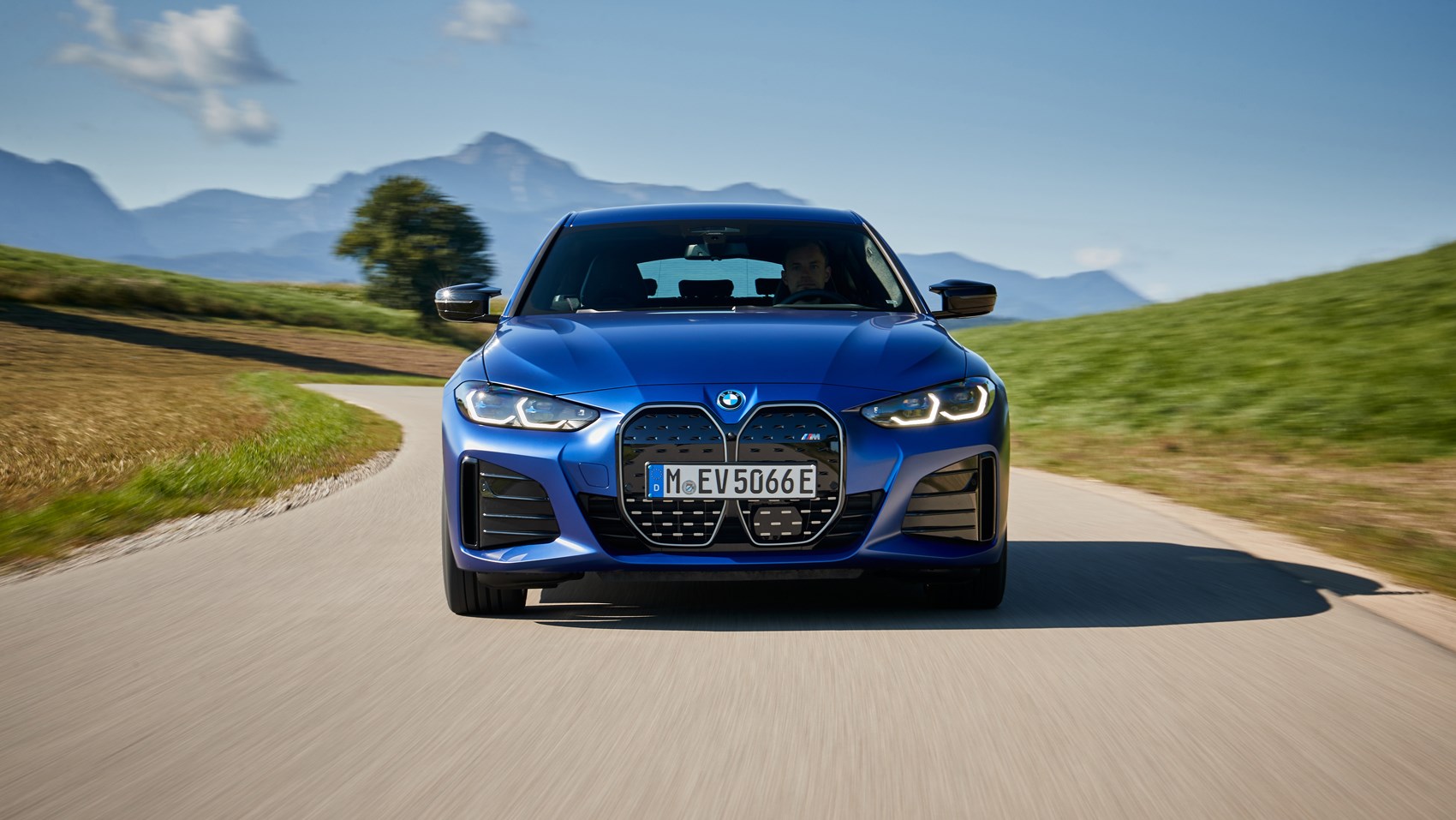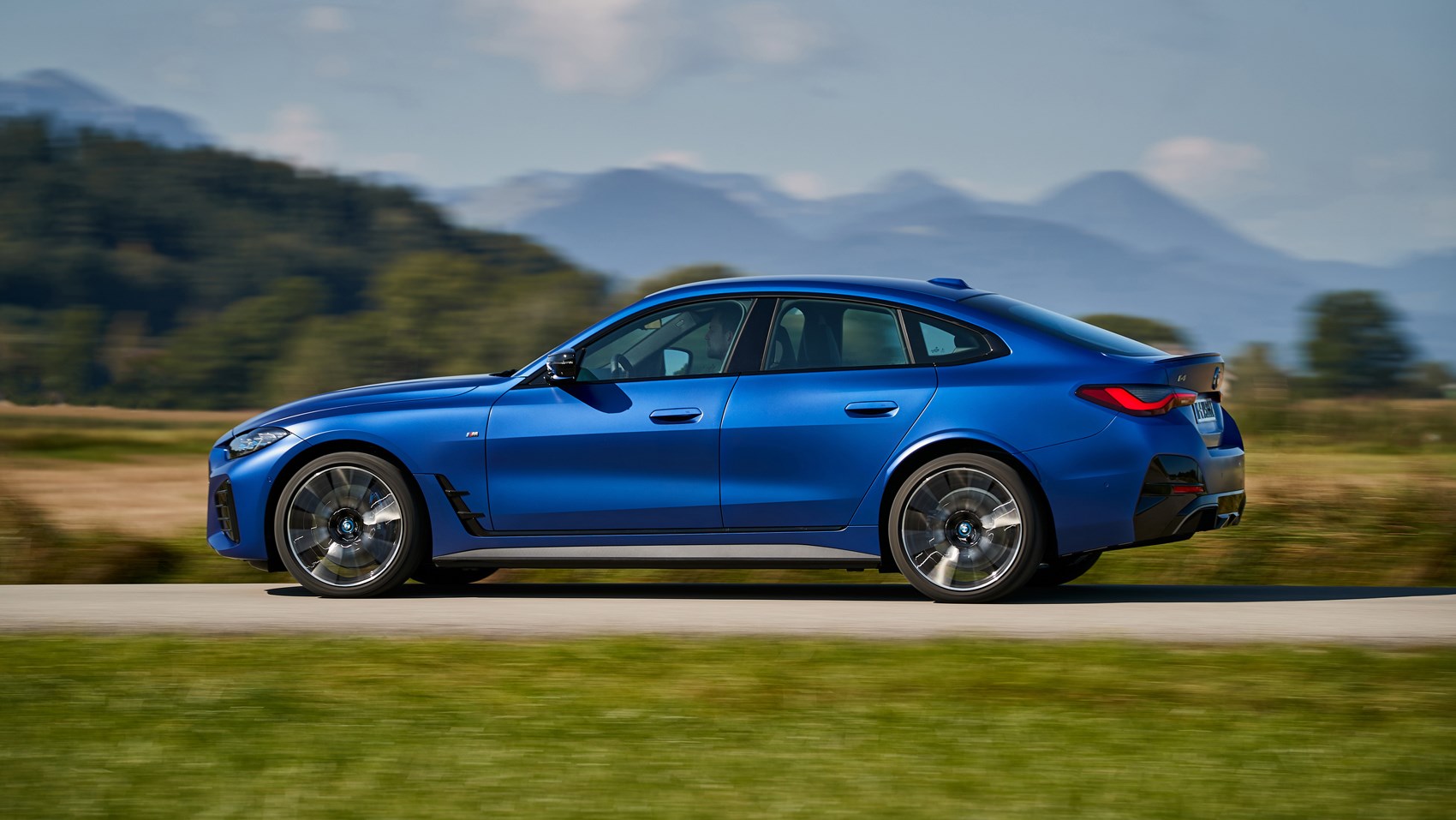► M50 version tested with up to 537bhp
► 318-mile driving range is possible
► 0-62mph in 3.9 seconds
It’s been a long time coming, but BMW has now finally begun kicking the combustion engines out of the core of its model range. While this new i4 might not quite be the electric 3-series some of you are probably crying out for, being based on the same body-in-white as the 4-series Gran Coupe means you get a similar degree of passenger practicality alongside a swoopier roofline and a hatchback tailgate.
What’s more, BMW has gone straight for the jugular here. While you can buy a 335bhp i4 eDrive40 model with one motor and rear-wheel drive, the car we’ve been testing – also available right from launch – is the i4 M50, a 537bhp twin-motor all-wheel drive machine that also happens to be the first ever all-electric M-car.
Move over M3 and M4?
Not quite. Though the i4 M50 is more powerful – and certainly more muscular, with a stonking 586lb ft available instantly – it’s also around 300kg heavier. So, while it easily matches the (503bhp, 479lb ft) M4 Competition’s 3.9sec 0-62mph time, visually and dynamically it’s more of an M Performance model than a full-blown M3 replacement.

In fact, the breadth of chassis talent deployed here is quite something. Following – fast – in the tyre tracks of the BMW iX, the i4 M50 offers exceptional comfort and refinement, if you choose to take advantage of this. Yet the M-specific variable damping control (VDC) shock absorbers and variable-ratio steering can also serve up effortlessly sublime cornering talent without requiring a razor’s edge.
Does it use the same technology as the iX?
The i4 does without the fancy part-carbon construction of the iX, but takes full advantage of all the same Gen5 BMW electric drive tech.
This means clever electromagnet motors and the latest, high-density batteries, working together with highly integrated control systems that cover everything from the way the electric power is deployed across both axles of the i4 M50 to the manner the car is brought to a stop, using a seamless combination of recuperation and friction braking.

It doesn’t have quite as big a battery pack as the iX xDrive50, and consequently the i4 M50 has a 62-mile shorter 318-mile WLTP driving range. But it’s also 300kg lighter, can be charged at up to 205kW DC – giving you an 80% boost in as little as 31 minutes, though good luck finding a charger quite that juicy in the UK – and has slightly more power and torque.
You’ll also note the same dual-screen BMW Curved Display setup on the top of the dashboard inside – with the same BMW Operating System 8 iDrive infotainment, augmented nav and situational awareness.
Best of all, the i4 is considerably cheaper than the iX. And though that still means handing over £63,905 for the M50, even that represents a mighty £30k saving over the punchiest iX model thus far. A handy reduction, given so much of the fundamental technology is the same.
What’s the i4 M50 like to drive?
Comprehensively impressive, which is to say it’s quite the all-rounder.
Performance is nuts, in that staggeringly responsive electric car way. You don’t get the full 537bhp and 586lb ft all the time – default output is a mere 476hp and 538lb ft, with the full whack only unlocked using the Sport Boost function that features as an add-on to the regular Sport Mode. But regardless of setting, stab the accelerator and the i4 M50 reacts with the kind of instant thrust that makes you think of computer games. The Hans Zimmer soundtrack only enhance this impression, especially as this is particularly loud here, thanks to an M-specific remix. You can turn the noises off altogether, if you wish, but they actually work surprisingly well.

Less expected is the extent to which standing on the right pedal points the i4 M50’s nose at the sky. In fact, the effect is so comedic you almost wonder if it’s been done deliberately. But BMW claims it’s simply due to the sheer amount of torque the M50 is deploying with such little fanfare – and equally nothing to do with the back of the car being equipped with air springs instead of the conventional steel coils that are still used at the front.
It’s quite unusual to see that combination on a performance car – more typically rear air is use for self-levelling on fancy estates. Together with the VDC, however, it gives the i4 M50 really superb comfort levels, even if you insist on travelling everywhere in Sport.
A side-effect of this comfort seems to be a noticeable amount of lateral weight transfer in the corners at first. Give it time, though, and you get the sense that this is really caused by slightly over-driving the car, perhaps in part due to the M50’s variable-ratio steering. There are moments on the test route where the front of the i4 seems to be getting away from the back, pushing on the entry to turns in a manner that seems suspiciously like understeer. Yet there are other occasions when the i4 hooks up through a sequence of bends so completely it’s like you’re experiencing some kind of automotive epiphany – and these highs soon come to outweigh those initial impressions.

Afterall, traction is otherwise immense, thanks to the speed the two motors can shuffle the balance of power front and back. And the centre of gravity is some 37mm lower than that of a 3-series, thanks to the enormous battery pack at the bottom of the car. Bolted in at 22 points – including tying into the front subframe – the pack also helps endow the i4’s structure with a degree of stiffness that far surpasses petrol and diesel models using the same basic body. The i4 benefits from additional strengthening in other areas as well, including a front strut brace on the M50, plus a wider track and revised front suspension geometry.
All told, you get the distinct idea that internal combustion is starting to be seen as old fashioned at BMW as well.
BMW i4 M50: verdict
On top of everything else, there are some 40 driver assistance technologies available, a vast array of options, and more to come via over-the-air updates. In most respects, the i4 is just as much of a cutting-edge electric car experience as the iX, wrapped up in much less controversial packaging.
Given the performance, the comfort, the driving range and the capability, it’s hard to imagine how BMW can’t be onto a winner here. Unless you were expecting a true electric M4, in which case the i4 M50 is perhaps a touch too rounded and polite.

Read more BMW reviews here